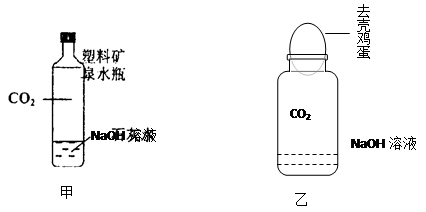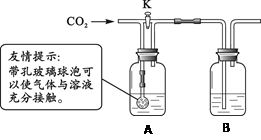(12分)(1)学习二氧化碳性质时,老师做了如右图所示的实验。结果发现,澄清石灰水变浑浊。请写出澄清石灰水变浑浊有关反应的化学方程式_____________________。

老师提出:氢氧化钠与氢氧化钙同属于碱类化合物,与氢氧化钙的化学性质相似,那么,氢氧化钠能否与二氧化碳反应呢?
同学们围绕着这个问题,通过查阅资料得知:常温下,CO2+2NaOH=Na2CO3+H2O。
接着,在老师指导下,完成了如下实验:将上述实验中的澄清石灰水换成氢氧化钠溶液,向其中通入CO2,观察到的实验现象为_________________________。
(2)为了验证CO2能与氢氧化钠发生化学反应,同学们设计了如下实验

①甲实验:向盛满CO2的塑料矿泉水瓶(质软)中加入一定量NaOH溶液,迅速旋紧瓶塞,并振荡。静止一会儿后观察到的实验现象为________________________。
②乙实验:向盛满CO2的集气瓶中倒入一定量NaOH溶液,迅速在瓶口处塞上一个去壳熟鸡蛋,静止一会儿后可观察到的实验现象为________________________。
(3)做完上述实验后,部分同学提出质疑,认为上述实验不足以说明CO2与氢氧化钠发生了化学反应。你认为这部分同学提出上述质疑,主要考虑的干扰因素是________________。为了进一步验证CO2能与氢氧化钠发生化学反应,同学们又设计了如下实验:

①A瓶盛装的试剂是________________,B瓶盛装的试剂是______________,实验时应_____
[填“打开”或“关闭”]活塞K。
②进行此实验时,通入CO2的体积应__________[填“大于”、“等于”或“小于”]A瓶溶液的体积。
③能证明CO2能与氢氧化钠发生化学反应的实验现象是______________________________。
(12分)
(1)CO2+Ca(OH)2=CaCO3↓+H2O。无明显变化。
(2)①塑料瓶变瘪 ②鸡蛋被吞入瓶中
(3)可能是CO2溶于水造成塑料瓶变瘪。
①NaOH溶液,澄清石灰水,关闭。
②大于
③A、B中均无明显现象。
(1)二氧化碳可以和澄清石灰水反应生成白色沉淀,可以据此写出其反应的化学方程式,而二氧化碳与氢氧化钠反应生成的是可溶性的碳酸钠和水,所以没有明显现象;
(2)①二氧化碳溶于氢氧化钠后,会使塑料瓶内的压强减小,大气压就会把塑料瓶压瘪了;
②二氧化碳溶于氢氧化钠后,会使塑料瓶内的压强减小,大气压就会把鸡蛋压入瓶中;
(3)由于二氧化碳也会溶于水,所以上述实验不足以说明CO2与氢氧化钠发生了化学反应;
①要探究二氧化碳能否与氢氧化钠反应,必须有氢氧化钠,而验证是否充分反应则需要借助于氢氧化钙溶液,所以在A装置中装入氢氧化钠溶液,而在B装置中装入氢氧化钙溶液,开始实验时为了让二氧化碳通过氢氧化钠溶液应该将活塞K关闭;
②二氧化碳在水中的溶解力为一体积的水溶解一体积的二氧化碳,所以为了排除水的干扰,通入二氧化碳的体积应该大于A中液体的体积;
③最终如果B装置中的澄清石灰水不变浑浊,则说明在二氧化碳与氢氧化钠溶液发生了反应.
故答案为:
(1)CO2+Ca(OH)2═CaCO3↓+H2O;无明显变化;
(2)①塑料瓶变瘪;
②鸡蛋被吞入瓶中;
(3)可能是CO2溶于水造成塑料瓶变瘪;
①NaOH溶液;澄清石灰水;关闭;
②大于;
③A、B中均无明显现象.
